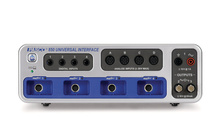



As the bicep muscle cord is pulled a short distance, the end of the arm moves through a very large distance, showing the mechanical advantage of the arm. The load at the end of the arm can be varied.

To perform this motion, an elastic cord is used as the bicep muscle cord and the tricep muscle cord are pulled with a Force Sensor. The motion of the arm and the release speed of the ball are measured with the built-in potentiometers using the Angle Sensor.


As the bicep muscle cord is pulled a short distance, the end of the arm moves through a very large distance, showing the mechanical advantage of the arm. The load at the end of the arm can be varied.

As the tricep muscle cord is pulled with a Force Sensor, another fixed Force Sensor records the tension in the bicep muscle cord.










Mechanical model that simulates the muscles and motion of an actual human arm. To activate the motion students pull on the cord.
See the Product Description for this item's included accessories.
See the Buying Guide for this item's required, recommended, and additional accessories.
Product Summary
The Human Arm Model simulates the muscles and motion of an actual human arm. Students pull on the cord with a Force Sensor to activate the arm motion. Changes in position are measured at the shoulder and elbow using the two built-in potentiometers and the included Angle Sensor (PS-2139). From this information, the torque applied when lifting an object can be determined. Students may also evaluate the work done by the arm when throwing a ball and the resulting kinetic energy delivered to the ball.
The Arm can perform many types of motion such as extending and lifting an object, curling, or throwing a ball overhand. Different arm muscles are activated depending on which pulleys are selected. Static force measurements can also be made to see how the muscle tension changes at various arm positions.
Developed in cooperation with Nancy Beverly, Associate Professor of Physics at Mercy College, Dobbs Ferry, New York.
Features
- Working Model of the Human Arm
- Associate Triceps/Biceps Muscle Action with Arm Motion
- Measure Torque Resulting from Lifting Weights
- Actually Throws a Ball
What's Included
- 1x Arm
- 1x Human Arm Model
- 1x Angle Sensor
- 1x Angle Sensor PS-2139
- 1x Removable Mass
- 1x Cord & Cord Locks
- 1x Mounting Bracket with Rod
- 1x Force Sensor Mounting Rod
- 1x Rubber Ball
Data Collection Software
This product requires PASCO software for data collection and analysis. We recommend the following option(s). For more information on which is right for your classroom, see our Software Comparison: SPARKvue vs. Capstone »
Interface Required
This product requires a PASCO Interface to connect to your computer or device. We recommend the following option(s). For a breakdown of features, capabilities, and additional options, see our Interface Comparison Guide »
Buying Guide
| Required Accessories | P/N | Price |
|---|---|---|
| 1x “C” Clamp or Large Table Clamp | -- | -- |
| 2x PASPORT Force Sensor | PS-2104 | -- |
| Recommended Accessories | P/N | Price |
|---|---|---|
| Wireless Force Acceleration Sensor | PS-3202 | -- |
Support Documents
| Manuals | ||
|---|---|---|
| Human Arm Model Manual | English - 1.97 MB | |
| Knowledge Base | ||
| Rotational inertia for portions of human arm model | Aug 29th, 2023 | |






